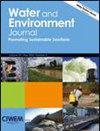Water Transfer Energy Efficiency Index for inter‐basin water transfer projects
IF 1.8
4区 环境科学与生态学
Q4 ENVIRONMENTAL SCIENCES
引用次数: 0
Abstract
Inter‐basin water transfer projects (WTPs) address water scarcity by lifting water uphill, posing energy challenges due to diverse topography. This study therefore analyses historical trends in WTP distance, average annual water volumes delivered, water lift and pumping capacity to develop the Water Transfer Energy Efficiency Index (WTEEI) and apply it for the assessment of WTPs. Results indicate that the WTEEI is a valuable tool for evaluating WTP energy efficiency. While no definitive trend in WTEEI values was observed, the findings suggest the need for monitoring of energy use of WTPs and more research to better understand and improve the energy efficiency of these large‐scale infrastructure projects. By introducing a simple, intuitive and rapid assessment tool for evaluating energy efficiency in WTPs, this study addresses a critical gap in the water–energy field, namely, the evaluation of energy usage in WTPs and the identification of energy‐efficiency improvements for current and future WTPs.流域间调水项目的调水能效指数
跨流域输水工程(WTP)通过上山提水来解决水资源短缺问题,但由于地形复杂多样,这对能源提出了挑战。因此,本研究分析了输水站距离、年均输水量、提水量和抽水能力的历史趋势,制定了输水能效指数(WTEEI),并将其应用于输水站评估。结果表明,WTEEI 是评估水处理厂能效的重要工具。虽然没有观察到 WTEEI 值的明确趋势,但研究结果表明有必要监测水处理项目的能源使用情况,并开展更多研究,以更好地了解和提高这些大型基础设施项目的能源效率。通过引入一种简单、直观和快速的评估工具来评估水处理项目的能效,本研究填补了水能领域的一个重要空白,即评估水处理项目的能源使用情况,并为当前和未来的水处理项目确定能效改进措施。
本文章由计算机程序翻译,如有差异,请以英文原文为准。
求助全文
约1分钟内获得全文
求助全文
来源期刊

Water and Environment Journal
环境科学-湖沼学
CiteScore
4.80
自引率
0.00%
发文量
67
审稿时长
18-36 weeks
期刊介绍:
Water and Environment Journal is an internationally recognised peer reviewed Journal for the dissemination of innovations and solutions focussed on enhancing water management best practice. Water and Environment Journal is available to over 12,000 institutions with a further 7,000 copies physically distributed to the Chartered Institution of Water and Environmental Management (CIWEM) membership, comprised of environment sector professionals based across the value chain (utilities, consultancy, technology suppliers, regulators, government and NGOs). As such, the journal provides a conduit between academics and practitioners. We therefore particularly encourage contributions focussed at the interface between academia and industry, which deliver industrially impactful applied research underpinned by scientific evidence. We are keen to attract papers on a broad range of subjects including:
-Water and wastewater treatment for agricultural, municipal and industrial applications
-Sludge treatment including processing, storage and management
-Water recycling
-Urban and stormwater management
-Integrated water management strategies
-Water infrastructure and distribution
-Climate change mitigation including management of impacts on agriculture, urban areas and infrastructure
 求助内容:
求助内容: 应助结果提醒方式:
应助结果提醒方式:


